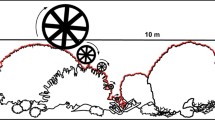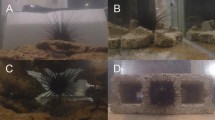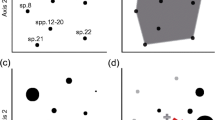Abstract
Despite a large number of studies focusing on the complexity of coral reef habitats and the characteristics of associated fish assemblages, the relationship between reef structure and fish assemblages remains unclear. The textural discontinuity hypothesis, which proposes that multi-modal body size distributions of organisms are driven by discontinuous habitat structure, provides a theoretical basis that may explain the influence of habitat availability on associated organisms. In this study we use fractal techniques to characterize patterns of cross-scale habitat complexity, and examine how this relates to body-depth abundance distributions of associated fish assemblages over corresponding spatial scales. Our study demonstrates that: (1) Reefs formed from different underlying substrata exhibit distinct patterns of cross-scale habitat complexity; (2) The availability of potential refuges at different scales correlates with patterns in fish body depth distributions, but habitat structure is more strongly related to the relative abundance of fish in the body depth modes, rather than to the number of modes; (3) As reefs change from coral- to algal-dominated states, the complexity of the underlying reef substratum may change, presenting a more homogenous environment to associated assemblages; (4) Individual fish body depth distributions may be multi-modal, however, these distributions are not static characteristics of the fish assemblage and may change to uni-modal forms in response to changing habitat condition. In light of predicted anthropogenic changes, there is a clear need to improve our understanding of the scale of ecological relationships to anticipate future changes and vulnerabilities.


Similar content being viewed by others
References
Ackerman JL, Bellwood DR, Brown J. 2004. The contribution of small individuals to density-body size relationships: examination of energetic equivalence in reef fishes. Oecologia 139:568-571.
Ackerman JL, Bellwood DR. 2000. Reef fish assemblages: a re-evaluation using enclosed rotenone stations. Mar Ecol Prog Ser 206:227-237.
Allen CR, Garmestani AS, Havlicek TD, Marquet PA, Peterson GD, Restrepo C, Stow CA, Weeks BE. 2006. Patterns in body mass distributions: sifting among alternative hypotheses. Ecol Lett 9:630-643.
Alvarez-Filip L, Dulvy NK, Gill JA, Cote IM, Watkinson AR. 2009. Flattening 465 of Caribbean coral reefs: region-wide declines in architectural complexity. Proc R Soc B 276:3019-3025.
Andres NG, Rodenhouse NL. 1993. Resilience of corals to hurricanes—a simulation-model. Coral Reefs 12:167–75.
Bartholomew A, Shine RL. 2008. Space size relative to prey width (Sp/Py) influences macrofaunal colonization of artificial structures. Mar Ecol-Prog Ser 358:95–102.
Bejarano S, Mumby P, Sotheran I. 2011. Predicting structural complexity of reefs and fish abundance using acoustic remote sensing (RoxAnn). Mar Biol 158:489–504.
Bellwood DR, Hoey AS, Ackerman JL, Depczynski M. 2006. Coral bleaching, reef fish community phase shifts and the resilience of coral reefs. Glob Change Biol 12:1587–94.
Benjamini Y, Hochberg Y. 1995. Controlling the false discovery rate: a practical and powerful approach to multiple testing. J R Stat Soc Ser B (Met) 57:289–300.
Bergman KC, Ohman MC, Svensson S. 2000. Influence of habitat structure on Pomacentrus sulfureus, a western Indian Ocean reef fish. Environ Biol Fishes 59:243–52.
Blackburn TM, Gaston KJ. 1994. Animal body size distributions: patterns, mechanisms and implications. Trends Ecol Evol 9:471–4.
Bradbury RH, Reichelt RE, Green DG. 1984. Fractals in ecology: methods and interpretation. Mar Ecol Prog Ser 14:295–6.
Brown JH, Nicoletto PF. 1991. Spatial scaling of species composition: body masses of North American land mammals. Am Nat 138:1478–512.
Buckland ST, Magurran AE, Green RE, Fewster RM. 2005. Monitoring change in biodiversity through composite indices. Philos Trans R Soc B 360:243–54.
Cattaneo A. 1993. Size spectra of benthic communities in Laurentian streams. Can J Fish Aquat Sci 50:2659–66.
Clarke KR. 1993. Non-parametric multivariate analyses of changes in community structure. Aust J Ecol 18:117–43.
Cohen JE, Jonsson T, Carpenter SR. 2003. Ecological community description using the food web, species abundance, and body size. Proc Natl Acad Sci USA 100:1781–6.
Davenport J. 2004. Fractal dimension estimation in studies of epiphytal and epilithic communities: strengths and weaknesses. In: Seuront L, Strutton PG, Eds. Handbook of scaling methods in aquatic ecology. Boca Raton: CRC Press. p. 245–256.
Dornelas M, Connolly SR, Hughes TP. 2006. Coral reef diversity refutes the neutral theory of biodiversity. Nature 440:80–2.
Emslie MJ, Cheal AJ, Sweatman H, Delean S. 2008. Recovery from disturbance of coral and reef fish communities on the Great Barrier Reef, Australia. Mar Ecol-Prog Ser 371:177–90.
Ernest SKM. 2005. Body size, energy use, and community structure of small mammals. Ecology 86:1407–13.
Fewster RM, Buckland ST, Siriwardena GM, Baillie SR, Wilson JD. 2000. Analysis of population trends for farmland birds using generalized additive models. Ecology 81:1970–84.
Fischer J, Lindenmayer DB, Montague-Drake R. 2008. The role of landscape texture in conservation biogeography: a case study on birds in south-eastern Australia. Divers Distrib 14:38–46.
Friedlander AM, Brown EK, Jokiel PL, Smith WR, Rodgers KS. 2003. Effects of habitat, wave exposure, and marine protected area status on coral reef fish assemblages in the Hawaiian archipelago. Coral Reefs 22:291–305.
Friedlander AM, DeMartini EE. 2002. Contrasts in density, size, and biomass of reef fishes between the northwestern and the main Hawaiian Islands: the effects of fishing down apex predators. Mar Ecol-Prog Ser 230:253–64.
Friedlander AM, Parrish JD. 1998. Habitat characteristics affecting fish assemblages on a Hawaiian coral reef. J Exp Mar Biol Ecol 224:1–30.
Gagné SA, Proulx R, Fahrig L. 2008. Testing Holling’s textural-discontinuity hypothesis. J Biogeogr 35:2149–50.
Gotelli NJ, Ellison AM. 2004. A primer of ecological statistics. Sunderland, MA: Sinauer Associates Inc. p 510 p.
Graham NAJ, Dulvy NK, Jennings S, Polunin NVC. 2005. Size-spectra as indicators of the effects of fishing on coral reef fish assemblages. Coral Reefs 24:118–24.
Graham NAJ, Wilson SK, Jennings S, Polunin NVC, Bijoux JP, Robinson J. 2006. Dynamic fragility of oceanic coral reef ecosystems. Proc Natl Acad Sci USA 103:8425–9.
Graham NAJ, Wilson SK, Jennings S, Polunin NVC, Robinson J, Bijoux JP, Daw TM. 2007. Lag effects in the impacts of mass coral bleaching on coral reef fish, fisheries, and ecosystems. Conserv Biol 21:1291–300.
Greenwood JJD, Gregory RD, Harris S, Morris PA, Yalden DW. 1996. Relations between abundance, body size and species number in British birds and mammals. Philos Trans R Soc Lond B Biol Sci 351:265–78.
Halley JM, Hartley S, Kallimanis AS, Kunin WE, Lennon JJ, Sgardelis SP. 2004. Uses and abuses of fractal methodology in ecology. Ecol Lett 7:254–71.
Hartley S, Kunin WE, Lennon JJ, Pocock MJO. 2004. Coherence and discontinuity in the scaling of species’ distribution patterns. Proc R Soc Lond 271:81–8.
Havlicek TD, Carpenter SR. 2001. Pelagic species size distributions in lakes: are they discontinuous? Limnol Oceanogr 46:1021–33.
Hixon MA, Beets JP. 1993. Predation, prey refuges, and the structure of coral-reef fish assemblages. Ecol Monogr 63:77–101.
Hoey AS, Bellwood DR. 2011. Suppression of herbivory by macroalgal density: a critical feedback on coral reefs? Ecol Lett 14:267–73.
Holling CS. 1992. Cross-scale morphology, geometry, and dynamics of ecosystems. Ecol Monogr 62:447–502.
Hughes TP, Rodrigues MJ, Bellwood DR, Ceccarelli D, Hoegh-Guldberg O, McCook L, Moltschaniwskyj N, Pratchett MS, Steneck RS, Willis B. 2007. Phase shifts, herbivory, and the resilience of coral reefs to climate change. Curr Biol 17:360–5.
Jennings S, Grandcourt EM, Polunin NVC. 1995. The effects of fishing on the diversity, biomass and trophic structure of Seychelles’ reef fish communities. Coral Reefs 14:225–35.
Jennings S, Greenstreet SPR, Reynolds JD. 1999. Structural change in an exploited fish community: a consequence of differential fishing effects on species with contrasting life histories. J Anim Ecol 68:617–27.
Kaufman LS. 1983. Effects of Hurricane Allen on reef fish assemblages near discovery Bay, Jamaica. Coral Reefs 2:43–7.
Klinkenberg B. 1994. A review of methods used to determine the fractal dimension of linear features. Math Geol 26:23–46.
Kovalenko K, Thomaz S, Warfe D. 2012. Habitat complexity: approaches and future directions. Hydrobiologia 685:1–17.
Leaper R, Raffaelli D, Emes C, Manly B. 2001. Constraints on body-size distributions: an experimental test of the habitat architecture hypothesis. J Anim Ecol 70:248–59.
Ledlie M, Graham NAJ, Bythell J, Wilson SK, Jennings S, Polunin NVC, Hardcastle J. 2007. Phase shifts and the role of herbivory in the resilience of coral reefs. Coral Reefs 26:641–53.
Levin PS, Hay ME. 1996. Responses of temperate reef fishes to alterations in algal structure and species composition. Mar Ecol-Prog Ser 134:37–47.
Levin SA. 1992. The problem of pattern and scale in ecology: the Robert H. MacArthur Award Lecture. Ecology 73:1943–67.
Mandelbrot BB. 1982. The fractal geometry of nature. New York: W.H. Freeman and Company. 468 p.
Martin-Garin B, Lathuiliere B, Verrecchia EP, Geister J. 2007. Use of fractal dimensions to quantify coral shape. Coral Reefs 26:541–50.
McAbendroth L, Ramsay PM, Foggo A, Rundle SD, Bilton DT. 2005. Does macrophyte fractal complexity drive invertebrate diversity, biomass and body size distributions? Oikos 111:279–90.
Morse DR, Lawton JH, Dodson MM, Williamson MH. 1985. Fractal dimension of vegetation and the distribution of arthropod body lengths. Nature 314:731–3.
Munday PL, Jones GP. 1998. The ecological implications of small body size among coral-reef fishes. Oceanogr Mar Biol Annu Rev 36:373–411.
O’Neill RV, DeAngelis DL, Waide JB, Allen TFH. 1986. A hierarchical concept of ecosystems. Princeton, NJ: Princeton University Press.
Olden JD, Hogan ZS, Zanden MJV. 2007. Small fish, big fish, red fish, blue fish: size-biased extinction risk of the world’s freshwater and marine fishes. Glob Ecol Biogeogr 16:694–701.
Peterson GD, Allen CR, Holling CS. 1998. Ecological resilience, biodiversity, and scale. Ecosystems 1:6–18.
Pratchett M, Munday PL, Wilson SK, Graham NAJ, Cinner J, Bellwood DR, Jones GP, Polunin NVC, McClanahan T. 2008. Effects of climate-induced coral bleaching on coral-reef fishes: ecological and economic consequences. Oceanogr Mar Biol Annu Rev 46:251–96.
Purkis S, Kohler K. 2008. The role of topography in promoting fractal patchiness in a carbonate shelf landscape. Coral Reefs 27:977–89.
R Development Core Team. 2011. R: a language and environment for statistical computing. Vienna, Austria: R Project for Statistical Computing.
Robson BJ, Barmuta LA, Fairweather PG. 2005. Methodological and conceptual issues in the search for a relationship between animal body-size distributions and benthic habitat architecture. Mar Freshw Res 56:1–11.
Silliman BR, van der Koppel J, Bertness MD, Stanton LE, Mendelssohn IA. 2005. Drought, snails, and large-scale die-off of southern U.S. salt marshes. Science 310:1803–6.
Stead TK, Schmid-Araya JM, Schmid PE, Hildrew AG. 2005. The distribution of body size in a stream community: one system, many patterns. J Anim Ecol 74:475–87.
Sugihara G, May R. 1990. Applications of fractals in ecology. Trends Ecol Evol 5:79–86.
Thibault KM, White EP, Hurlbert AH, Ernest SKM. 2011. Multimodality in the individual size distributions of bird communities. Glob Ecol Biogeogr 20:145–53.
Tilman D, Fargione J, Wolff B, D’Antonio C, Dobson A, Howarth R, Schindler D, Schlesinger WH, Simberloff D, Swackhamer D. 2001. Forecasting agriculturally driven global environmental change. Science 292:281–4.
Tokeshi M, Arakaki S. 2012. Habitat complexity in aquatic systems: fractals and beyond. Hydrobiologia 685:27–47.
Vergnon R, Dulvy NK, Freckleton RP. 2009. Niches versus neutrality: uncovering the drivers of diversity in a species-rich community. Ecol Lett 12:1079–90.
Watson D, Harvey E, Fitzpatrick B, Langlois T, Shedrawi G. 2010. Assessing reef fish assemblage structure: how do different stereo-video techniques compare? Mar Biol 157:1237–50.
White EP, Ernest SKM, Kerkhoff AJ, Enquist BJ. 2007. Relationships between body size and abundance in ecology. Trends Ecol Evol 22:323–30.
Wiens JA. 1989. Spatial scaling in ecology. Funct Ecol 3:385–97.
Wilding TA, Rose CA, Downie MJ. 2007. A novel approach to measuring subtidal habitat complexity. J Exp Mar Biol Ecol 353:279–86.
Wilkinson CR. 2000. World-wide coral reef bleaching and mortality during 1998: a global climate change warning for the new millenium? In: Sheppard CRC, Ed. Seas at the millennium: an environmental evaluation. Amsterdam: Elsevier Science. p. 43–57.
Wilson SK, Fisher R, Pratchett MS, Graham NAJ, Dulvy NK, Turner RA, Cakacaka A, Polunin NVC. 2010. Habitat degradation and fishing effects on the size structure of coral reef fish communities. Ecol Appl 20:442–51.
Wilson SK, Fisher R, Pratchett MS, Graham NAJ, Dulvy NK, Turner RA, Cakacaka A, Polunin NVC, Rushton SP. 2008. Exploitation and habitat degradation as agents of change within coral reef fish communities. Glob Change Biol 14:2796–809.
Wilson SK, Graham NAJ, Polunin NVC. 2007. Appraisal of visual assessments of habitat complexity and benthic composition on coral reefs. Mar Biol 151:1069–76.
Wilson SK, Graham NAJ, Robinson J, Nash KL, Chong-Seng K, Polunin NVC, Aumeeruddy R, Quatre R. 2012. Macroalgal expansion and marine protected areas drive coral recovery following climatic disturbances. Conserv Biol 26:995–1004.
Wood SN. 2006. Generalized additive models: an introduction with R. Boca Raton: Chapman & Hall/CRC. p. 410.
Yamanaka T, White PCL, Spencer M, Raffaelli D. 2012. Patterns and processes in abundance-body size relationships for marine benthic invertebrates. J Anim Ecol 81:463–71.
Acknowledgments
This study was funded by the Australian Research Council and the Queensland Smart Futures Fund. We thank Ross Barrett for making the measuring wheels, and two anonymous reviewers for their helpful comments.
Author information
Authors and Affiliations
Corresponding author
Additional information
Author Contributions
The original idea was conceived by KLN; KLN, NAJG and DRB contributed to study design; KLN, NAJG and SKW performed the research; KLN analysed the data and wrote the first draft; all authors contributed to general paper development.
Electronic supplementary material
Below is the link to the electronic supplementary material.
Rights and permissions
About this article
Cite this article
Nash, K.L., Graham, N.A.J., Wilson, S.K. et al. Cross-scale Habitat Structure Drives Fish Body Size Distributions on Coral Reefs. Ecosystems 16, 478–490 (2013). https://doi.org/10.1007/s10021-012-9625-0
Received:
Accepted:
Published:
Issue Date:
DOI: https://doi.org/10.1007/s10021-012-9625-0




